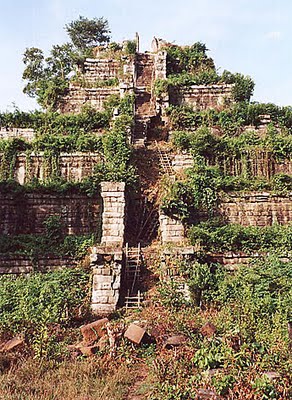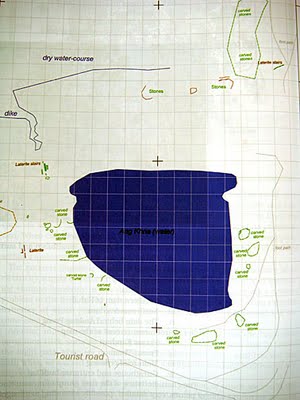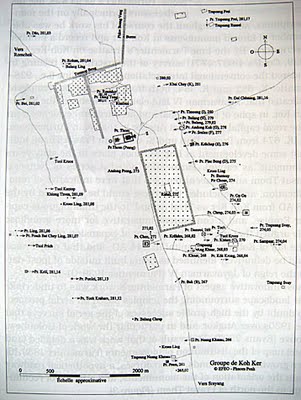Koh Ker's heritage
 The temple pyramid known as the Prang of Prasat Thom at Koh Ker, when the top was still accessible in 2001
The temple pyramid known as the Prang of Prasat Thom at Koh Ker, when the top was still accessible in 2001Koh Ker means 'island of glory' though it was formerly known by the name Chok Gar Gyar ('the koki-tree thicket') and even Lingapura when Jayavarman IV proclaimed himself 'supreme king of the Khmer kings' at Koh Ker in 928. Knowledge of this king's early days are scratchy, but what is known is that he commenced and completed an incredible array of over 40 temples during a frenzied twenty year period before his death in 940 and a return of the royal court to Angkor a few years later. The first man-made creation at Koh Ker was the baray, known as Rahal. The most memorable of the monuments is the Prang of Prasat Thom, a 32 metre high temple-pyramid, the largest ever built, rising over seven levels and originally crowned by a giant linga more than a metre in diameter. The linga disappeared long ago. The prang is no longer accessible by visitors for safety reasons. The five unique temples, some 750 metres east of Prasat Thom, each contained a massive linga on its yoni pedestal, each linga estimated to weigh some fifteen tons, some carved from a single rock. Inscriptions abound at Prasat Krachap, with over a thousand lines of script, a huge statue of Ganesha is known to have been stolen from Prasat Bak after the civil war, Prasat Chen produced the famous monkey brothers statue that is housed at the national museum, whilst Prasat Thom gave up the colossal garuda that stands at the entrance of the capital's museum. The rock carvings at Ang Khna, dotted around the pond known as Trapeang Khna, contain a variety of reliefs depicting deities and animal shapes, including a monitor lizard and a pair of freshwater dugongs. There's a suggestion that these sacred carvings were made by hermits at a later date. One other noteworthy monument is Prasat Andong Kuk, which is the last temple to be built and has been identified as one of the hospitals created by Jayavarman VII and shows that the city was still active as late as the 12th century. There is still so much to uncover about Koh Ker. It still holds many mysteries but the completion of a master plan will set the wheels in motion for those investigations to take place. We await the results with great interest.
 The green type and shapes surrounding the pond of Trapeang Khna denote carved rocks which include lingas and animals
The green type and shapes surrounding the pond of Trapeang Khna denote carved rocks which include lingas and animalsLabels: Koh Ker



1 Comments:
Vintage Andy! Thats why I count myself among your readers. Now u can resume with the footy madness (for a time). Cheers, Gerrick
Post a Comment
<< Home